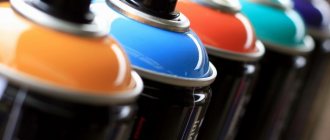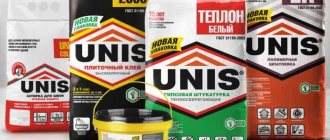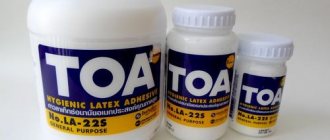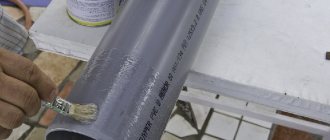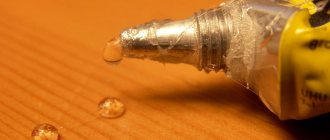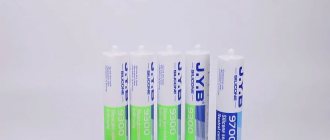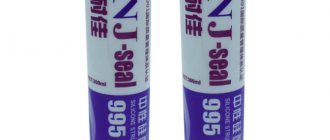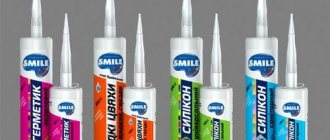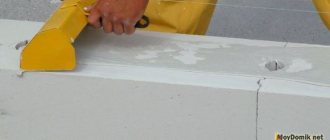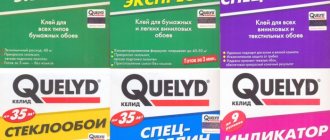What is adhesive in aerosol packaging - description
Glue in a can or aerosol glue is a universal fixing agent suitable for bonding homogeneous and different-textured materials. A special feature is the release form - it is sold in bottles with a sprayer, representing a spray adhesive. Thanks to this it has the following advantages:
- easy way to use;
- creating a thin, even layer;
- the ability to adjust the thickness of the seam;
- application to large areas, in hard-to-reach places, if required;
- no need to purchase rollers or spatulas;
- economical consumption;
- long shelf life (due to the tightness of the packaging);
- transparency of the composition, the possibility of application even on colored products;
- absence of stains, smudges, streaks after drying;
- ability to replace double-sided tape.
The composition of aerosol glue does not differ from its analogues, the only difference is that it does not need to be squeezed out or poured from tubes or bottles. Despite the higher cost, such means are very popular, because even in the most remote corners of parts they create reliable, strong connections. Most aerosol adhesives have a high level of adhesion to various surfaces and have a fast setting time. As they dry, they do not lead to warping of fabric and other thin materials and are practically invisible on products.
How to use and store
First of all, you need to read the instructions. No special skills are required for the job. Spray adhesive is not harmful to health and does not create unnecessary contamination during operation. However, when working, you should adhere to some rules.
Features of working with adhesive in the form of a spray:
- Before gluing, you need to degrease the surfaces and make sure that no particles of dust or lint get on them during the application process.
- Shake the can well before applying.
- Spraying should be carried out at a distance of 20-30 cm.
- You need to wait until it dries completely and only then use it.
- For better adhesion, you should press the products tightly or use a press.
Reference! While spraying, keep the can parallel to the surface. This will allow you to quickly and evenly apply the glue.
The can should be stored in a dry and dark place so that it is not exposed to sunlight. Storage temperature – from +5 to +30 degrees. The period of use is indicated by the manufacturer on the packaging. After it expires, the spray should not be used, as it loses its adhesive properties.
Spray adhesive is very convenient and easy to use for various jobs. If you take into account the area of use and characteristics when choosing, the product will fully cope with its task. The spray will always be popular due to its invisibility, fastening of a wide variety of materials and the ability to apply in hard-to-reach areas.
Aerosol glue (2 videos)
Types and uses of aerosol glue (25 photos)
Application area
Using this glue you can fasten parts made of a wide variety of materials. It is excellent for fabric, foam rubber, and wooden elements, which is why it is widely used in furniture production. It is also used for gluing plastic trim to furniture.
In creativity, aerosol glue can be used to fasten paper, cardboard, plastic, polymers, foil, polyethylene, and create complex shapes and structures. In everyday life, the product is used to glue metal, glass, and ceramics. It helps create a strong but flexible connection and seals leakage areas. In construction, spray adhesive allows you to work with the following products and materials:
- aerated concrete;
- foam blocks;
- insulation;
- artificial fibers;
- vinyl and PVC panels;
- insulation, etc.
Aerosol glue is useful for those who own a car: it is used to repair interior elements made of plastic and carpet, attach vibration insulation, trim, and even connect metal with plastic parts. In addition, using this product you can glue rubber and leather (natural, artificial).
General requirements for adhesives for foam rubber
In furniture production, foam rubber (elastic polyurethane foam) is a necessary and widely demanded material. Easy to cut, doesn't crumble, cheap. But choosing a good foam adhesive is not so easy: many adhesive compositions spoil the structure or are quickly absorbed and have a huge consumption.
What glue is best to use for gluing foam rubber? The product must meet the following requirements:
- sufficient viscosity, good elasticity - if the glue is thick and homogeneous, the seam will be strong and flexible, but with a liquid texture the glue will flow;
- suitable shade - so that the appearance of the furniture is not damaged, you should select an adhesive that matches the color of the foam rubber;
- quick-drying structure - the glue must set quickly, the process takes no more than a few minutes, but during this period you can have time to move the base if there are flaws;
- one-component composition - high-quality glue is sold ready-made; its components do not need to be mixed with each other.
After assessing the composition, it is important to make sure that there is no trichloroethane in the glue - this substance is harmful to humans and spoils the foam rubber. A good product contains rubber, water, solvents, and a number of other targeted additives
You can use materials based on polyurethane, neoprene, butadiene-styrene.
Using high-quality glue, you can glue foam rubber not only to wood: the composition is securely attached to plastic and metal. Most products are suitable for woodworking and shoe repair.
Properties and composition
The adhesive may contain any components that are found in other adhesives. Most often, adhesives have a rubber base, which is diluted with organic and other solvents. There are also products on sale on a different basis - polyurethane, styrene butadiene, neoprene. For creativity, they usually buy water-based adhesives containing acrylic resins. Any adhesive in a spray contains liquefied gas, which ensures its release to the surface.
The properties of adhesives are as follows:
- quick drying, no need for long fixation of products;
- high degree of adhesion, strength;
- heat resistance, some products have frost resistance;
- gentle treatment even of delicate materials;
- moisture resistance (for some products);
- no damage due to ultraviolet radiation;
- elasticity.
How to glue foam rubber at home
- You need to cut a piece of foam rubber of the required size, which will ensure an even seam when gluing. To increase the adhesive properties of the bonded surfaces, they must first be cleaned, dust and dirt removed, and then degreased. You can use white spirit for this. Afterwards, the surfaces need to be dried.
- It is better to glue polyurethane foam at room temperature. Then the optimal thickening rate is ensured. Otherwise, glue consumption increases and the quality of the seam becomes worse.
- The tools can be brushes, rollers, or the composition can be sprayed from a spray can. If the glue is in a can, the spray distance is selected correctly. It is most economical to apply glue with a gun, but using a brush can cause overuse of the mixture.
- After carefully applying the composition, the parts must be pressed tightly together and wait until a seam forms. The drying time of the composition may vary, on average it can be 1-60 minutes.
- At home, it is necessary to ventilate the room. Some products contain harmful solvents.
- All work must be carried out away from open sources of fire, since both foam rubber and glue for it are highly flammable and combustible substances. The exception is water-based adhesives. If the material needs to be glued with this composition, it must first be moistened with water.
- If foam rubber is renewed in upholstered furniture, an additional piece of fabric must be glued over the adhesive seam. This will provide additional strength to the seam. If a metal or wooden base is being glued, the composition should be applied to only one hard surface.
Since foam rubber is a very delicate material, has a porous structure and is filled with air, all actions to paste it must be carried out very carefully
Foam rubber is considered one of the most common materials used in a wide variety of fields. The history goes back more than 50 years since the material became firmly established in the everyday life of every family. Thus, many do not resort to hiring workers for repairs and try to carry out the repair work themselves. For such purposes, the article examines in detail the pressing question of which adhesive for foam rubber will be optimal.
The foam material is 100 percent polyurethane filled with air cells. It has increased breathability, is not afraid of mold and can cope with temperatures both quite low and quite high. It is for these reasons that the material is so popular in everyday life and in production.
Before starting work, it is necessary to determine how to glue the polyurethane foam together. So, let's look at the main selection criteria and types of glue that are suitable for working with foam rubber
It is important to understand the advantages and disadvantages of a wide range of adhesives in order to make the right choice, as well as study the basic rules for gluing foam surfaces
Types of glue
Adhesives in sprays are divided depending on the properties, purpose, scope of application into the following types:
- For rubber. Contains rubber, does not destroy the rubber structure, does not cause its deterioration, drying out, or delamination.
- For metal or plastic. Typically, such products have the same composition, since they require approximately the same degree of strength.
- For carpets, rugs. They are used directly for laying such coatings, are convenient to use, and reduce work time.
- For paper, fabric. These products completely eliminate the appearance of marks on the surface.
- For smooth materials. Most often used for gluing metal, foil, film, polypropylene.
- Universal glue. This composition is suitable for absolutely all materials and holds even dissimilar surfaces together.
3M brand glue
Today, one of the most popular adhesive compositions is 3M aerosol waterproof adhesive. The spray is based on elastomers; dimethyl ether is used as a displacer. Solvents are cyclohexane, pentane, petroleum distillate, toluene and acetone. With high resistance to water, very low oil and gasoline resistance. The operating temperature range of 3M sprays is from -30 to +100 °C. They do not leave marks, the materials can be re-glued several times if necessary.
The line of 3M brand sprays includes a polymer universal adhesive that is used to fix metals, wood, plastics, polystyrene foam, artificial fabrics and much more, and products designed specifically for temporary and permanent fixation of certain types of materials of different thicknesses. They all have their own numbers and differ in composition, type of solvents, and type of jet.
Instructions for use
Before work, you need to thoroughly clean the base. This is a prerequisite, since without cleaning and degreasing, the adhesion of the composition may decrease. Remove all types of dirt, go over the parts with sandpaper, then wipe the base with solvent and alcohol. You also need to make sure that the product is completely dry.
Immediately before work, the glue must be brought into the room to warm it up, and then shaken to prevent the formation of sediment. When spraying, keep the spray at a distance of 15-20 cm from the part, strictly parallel to it. Only in this way will the spraying be uniform. Usually two layers are performed, between which there is a temporary break of 10 minutes.
If the material is highly porous, the applied layer of adhesive must be thicker. They act in a similar way if the weight of the part is significant. When connecting thin materials, it is enough to treat one of them with glue; thick objects are treated with everything on both sides. Complete drying time is 30-60 minutes or more depending on the type of composition. To preserve the glue until the next use, after completing the work you need to do the following:
- turn the container over;
- press the sprayer several times;
- make sure that air comes out of the cylinder;
- turn the bottle over again and close it;
- store away from bright sunlight and high temperatures (optimal conditions: +5...+30 degrees, in a dark place inaccessible to children).
How to glue acoustic foam
There are several types of glue for acoustic foam. Each of them has its own characteristics during the work.
One-component acrylic-based compositions - installation process:
- Prepare the area for the sticker. Clean it from debris and dust.
- Apply the adhesive mass to the acoustic slabs with a spatula, spreading it evenly over the entire surface.
- Press them against the wall.
It is enough to hold the panels under pressure for 1 minute so that they adhere securely to the wall.
Liquid nails - step-by-step instructions for use:
- Clean the work surface from all kinds of dirt and dust.
- Using a mounting gun, apply liquid nails to the wall in thin strips.
Using hot melt adhesive:
- Load the gun with a glue stick.
- Wait 15 minutes for the gun to warm up.
- Wipe work surfaces with a napkin.
- Mark the base for the slabs. Clean it from dirt and dust.
- Quickly apply the adhesive mass to the prepared base.
Press the acoustic panels against the wall and wait 1 minute.
Conclusion
It should be noted that now large and well-known manufacturers are not standing still, they are improving their range. Here is only a small list of adhesives for foam rubber. In fact, there are much more of them, because new specialized compositions specifically for this material are not uncommon in the construction market today. All that remains is to test them, so the choice is yours.
Foam rubber is considered a fairly popular material in various industries. To connect it to each other or to other surfaces, you need to carefully select and use glue.
Safety and recommendations
Compliance with safety measures when working with glue, as with other chemical compounds, is mandatory:
- work only in a ventilated area;
- protect your hands with gloves, work in special clothing;
- do not smoke when working, exclude other possibilities of contact with fire, otherwise the product may explode;
- In case of contact with skin, wash it immediately with soap;
- Wash clothes stained with glue immediately;
- do not place glue near alkalis, acids, or near a battery - it may deteriorate;
- Close the glue cap tightly when not in use.
You should not use glue after the expiration date - the level of its adhesion to materials decreases. Some adhesives (for example, acrylic) have almost no odor, but if they contain organic solvents, you still need to work with them using personal protective equipment.
How to make the right choice
Aerosol adhesives are chosen due to their strengths. These include:
- High strength, at the same time with elasticity.
- Fast setting.
- Convenient to use.
- High rate of adhesion to various substrates.
- Ability to work with various materials.
- Long shelf life.
- Dosed consumption.
- Safe for the human body (does not emit harmful fumes).
Before choosing an aerosol, you need to decide which materials will be combined most often. At the same time, it is necessary to pay attention to the operating conditions of the glued parts. The properties of the glue used will depend on this.
Review of manufacturers
There are now products from different manufacturers on the market - domestic and foreign. Users consider good adhesives 75 3M, 77 3M Scotch Weld, which are designed for bonding light and medium-heavy materials. The adhesives have high adhesion and are completely transparent.
Another high-quality composition is Done Deal. It is considered universal, suitable for leather, rubber, various fabrics, and glass. Often used for car repairs. Based on propane, butane, artificial rubber. Spray adhesive “888 Reinforced fixation” is a multi-purpose synthetic hydrocarbon material. It is suitable for wood, rubber, plastic, metal and many other materials. Helps to stick polystyrene foam onto any substrate.
Another good glue is SinTex. It contains non-flammable solvents and artificial rubber. The product is heat-resistant, elastic, allows you to apply a thin adhesive seam, and provides high bonding strength. Suitable for most known materials, including spunbond, cork, felt, and car carpet.
Adhesives "ZM"
The line of products of this brand is based on elastomers, dimethyl ether, and a number of solvents - pentane, toluene, cyclohexane. Adhesives are highly water resistant, but are not resistant to gasoline and oils. Operating temperatures vary within -30…+100 degrees. The line includes universal-use products, as well as special formulations for individual materials.
Aerosol glue Multi spray
Aerosol Multi Spray (Multi Spray) is produced in England. It is used for gluing metal, wood, veneer, plywood, plastic, and dissimilar materials. Even brick and cement coatings can be bonded using this method. It is widely used in shipbuilding, the automotive industry, and aviation. Using glue, you can attach the decor to any base.
Aerosol glue ABRO
It is made in America and is very popular among craftsmen. A special nozzle allows you to spray it in a very thin layer. The brand produces special and universal formulations, as well as high-strength, quick-drying products.
Aerosol adhesive is a unique product that not only reliably holds products together, but is also easy to apply. Its use allows you to solve the most complex repair problems with little time.
What varieties and brands are suitable
There are many types of glue that can be used for gluing foam rubber. This allows you to choose the best option.
88 p2
It is a popular substance often used by hobbyists and shoe repairers. It is also often used in enterprises. This glue is packaged in metal containers. They can have different volumes. It is recommended to apply the composition with a roller or brush.
88 n
This glue has been popular for quite some time. It is often called shoe. The substance is made on the basis of rubber. It can be used for fixing different materials. As a result, it is possible to obtain a durable seam that is resistant to low temperatures. The disadvantages include an unpleasant aroma and a long gluing time.
Sintex
Sintex glue is produced in the form of tubes or jars. However, the most convenient option is considered to be the substance in a cylinder. The basis of Sintex MF glue is rubber. The substance is used in the manufacture of furniture and mattresses. When using glue for foam rubber, it is possible to obtain a strong and elastic seam.
Sefox
This is a furniture adhesive that allows you to glue foam rubber or fix it on plastic, textiles, wood and other materials. This is a non-flammable composition that minimizes the risk of fires. The glue is characterized by a thick consistency, which makes it more economical.
Saba
The product is produced in the form of an aerosol and sprayed with a gun. Bonding increases the adhesion of the treated surfaces. The composition is considered non-flammable. It is completely harmless and resistant to elevated temperatures.
BF 6
The product is used for gluing fragments of foam rubber. The substance is easy to use. It is safe to use and odorless. Before work, the surface is moistened. It is recommended to apply the substance in 2 layers. The first one is made thin, the second one is applied only after the substance has completely dried.
See also
How to make wallpaper glue at home with your own hands, cooking methods
Olimpur
The composition is water based. It is recommended to apply it in a targeted manner. The substance is used to fix foam elements. The composition also allows you to glue foam rubber to foam plastic, plywood and other surfaces.
Rapid 100
The product does not contain solvent. It is considered non-flammable and helps to obtain a strong and even seam. The composition dries quickly and is often used to fix acoustic foam.
Tapicer
The composition is packaged in aerosol metal cans. Therefore, it is applied by spraying. The product is made on the basis of rubber and allows you to glue foam fragments or fix them on other materials.
AOC TAP R-01
The product is suitable for gluing upholstered furniture. The composition is not capable of combining foam rubber with wood or plastic. The basis of the substance is considered to be SBS rubber. It also contains reactive resins and solvent.
Universal PVA
This is a universal substance. To glue foam rubber to an uneven surface, it is first fixed with tape. The glue requires at least 24 hours to dry. The result is a rigid seam.
Foam rubber-2
The glue is used in the furniture industry. It helps fix foam rubber to metal, wood and other materials. The surface should first be cleaned, degreased and dried.
Titan Wild
The product is produced in 0.5 liter containers. It takes a day for the composition to dry. The result is a rigid and dense seam.
Crystal Moment
This product is produced in bottles with a capacity of 0.125 liters. The composition helps to glue different materials. The substance is easy to apply and holds foam fragments well.
Silicone sealant
The composition is released in tubes. It takes a day to dry. The result is a soft seam. It adheres well to foam rubber and materials that have different hardnesses.
Hot melt adhesive
The product is produced in the form of cylindrical sticks of different sizes. The composition fixes the foam rubber well. However, the seam after drying turns out to be very hard and dense. The substance dries quickly and loses its characteristics. Therefore, it is not used for fixing large surfaces.
Double sided tape
This product does not allow foam fragments to glue together. It has weak adhesion characteristics to any surfaces. Therefore, adhesive tape is not used to solve serious problems.
